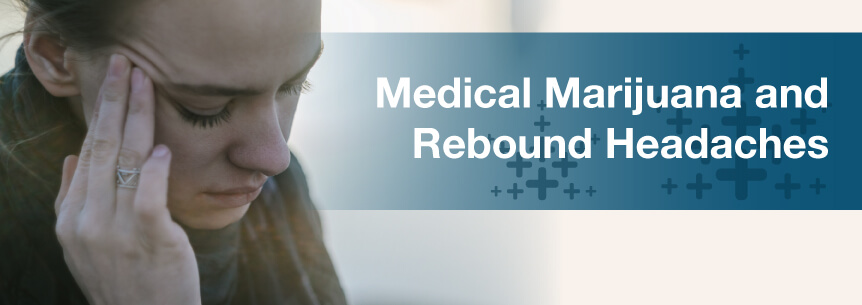
Headaches are an extensive public health concern with far-reaching societal and individual costs estimating to around $14 billion a year due to disability and a decrease in quality of life. In fact, around 47 percent of the population experiences headaches, increasing the need for effective headache treatments. Medical marijuana for rebound headaches is a potential treatment currently being used by patients and evaluated by physicians and researchers.
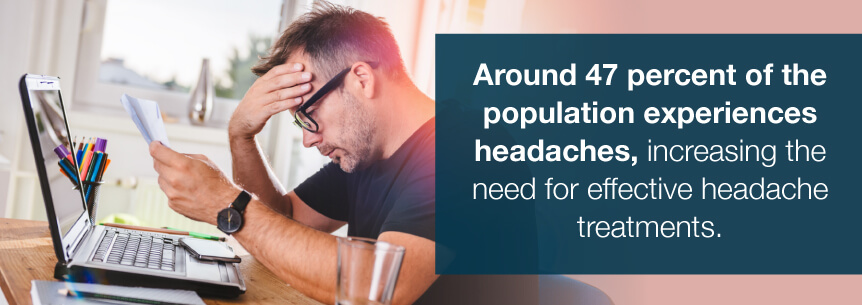
A rebound headache (RH) is a headache you get from long-term, regular use of pain medicine for headaches, such as migraines. While you obtain some pain relief from painkillers for your occasional pounding head, if you continue taking these relievers for more than a few days a week, it can lead to rebound headaches.
If you already suffer from a headache disorder, any pain medication can cause a rebound headache. Once you stop taking the pain medications, your rebound headaches will typically stop. While in the short term it can be difficult, with the help of your doctor, you should experience long-term relief.
If you have a history of migraines, tension headaches or transformed migraines, you’re more prone to getting rebound headaches when you are taking too much in the way of pain relievers.
On the other hand, if you’re taking pain relievers for a different type of condition, such as arthritis, and you don’t have a headache disorder, the pain relievers may not lead to rebound headaches.
A variety of pain medications can cause rebound headaches when taken in large amounts. Some common medications falling under this category include:
Although these medications are effective and safe when you take them in smaller amounts, eventually as you continue ingesting them, you can end up getting mild, long-lasting headaches. So, regularly taking these painkillers more frequently and at larger doses are not a good idea since they’ll make your headaches worse and persist indefinitely.
According to North American literature, initial descriptions of headaches caused by misuse of pain medications was first recognized in the 1950s. This phenomenon became more notable in the early 1980s.
Chronic headaches caused by treatment aren’t new per se, but how we define them and how we understand this concept have changed during the years. Rebound headache criteria isn’t based on formal evidence, but rather consensus.
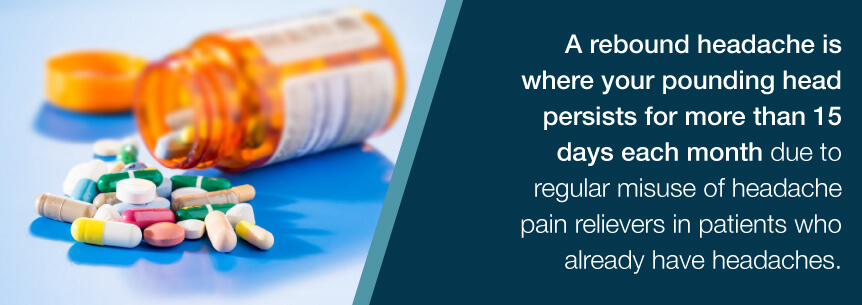
The description of a rebound headache is where your pounding head persists for more than 15 days each month due to regular misuse of headache pain relievers in patients who already have headaches. This is according to the International Classification of Headache Disorders-3 beta’s 2013 latest definition. But, this classification doesn’t include dosage used or the number of drug units — only how many days each month patients took the medication.
Symptoms and signs of RH can vary based on the medication you use and the primary headache type you’re treating. A rebound headache tends to occur almost every day and often wakes you up in the mornings early. It improves with pain relievers, but once the medication wears off, it returns.
Other symptoms and signs include:
Getting a headache every once and awhile is common — even normal. But, you need to take all headaches seriously. Some headaches could threaten your life. For instance, you should get medical attention right away if your headache:
Bleeding in the brain, a stroke and a brain tumor all can cause a headache and can be life threatening.
Talk with your physician if:
The typical rebound headache patient describes their headache to be:
Rebound headaches require almost daily or daily analgesics. Additionally, most of these patients have overlapping frequent and intense migraine attacks more drawn out than any intermittent migraine they’ve ever had in the past. Once patients develop these everyday headaches, they begin reporting depression symptoms such as:
People who are already prone to headaches tend to struggle with rebound headaches, typically individuals with either migraines themselves or a family history of them. And, as mentioned, they are typically only seen in people who are taking pain medication for headaches and not for ailments like back pain or arthritis.
Even after individuals stop the medication, they still report withdrawal symptoms that include a chronic headache. Their need to relieve these withdrawal symptoms bolsters even more use of pain relievers, which results in a nasty cycle of medicine misuse.
Also, if you’re overusing acute migraine medications, it can hinder preventative migraine medicines from doing their jobs effectively. Not to mention, they have the potential to damage your kidneys and liver.
According to the World Health Organization (WHO):
Discontinuing overuse of medicine is essential and represents the first treatment choice for rebound headaches. Additionally, your doctor should initiate preventative treatment with the goal of treating the questionable background main headache disorders either while you’re going through withdrawal or immediately after.
Some therapies can help with the medication withdrawal process and during medication withdrawal. For instance, bridge therapy may help provide symptomatic relief.
Along with discontinuing the medication, your doctor may also give you a combination of treatments such as:
These treatments can help improve your symptoms. Behavioral techniques and support groups have also been found to be successful for symptoms in addition to treatment. With biofeedback, counselors teach you how to control certain body responses to reduce pain effectively. You’ll learn how to control temperature, muscle tension, heart rate and diaphragmatic breathing. These help you get into a relaxed state, so you’re able to cope with your pain better.
When you do discontinue overusing the medication, you may go through some time where your headache gets worse. Some withdrawal symptoms you may experience during this time include:
However, your headaches will start getting better eventually.
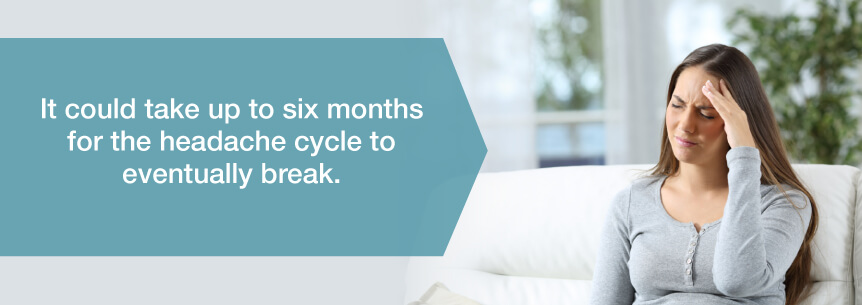
Your doctor will determine if you need to discontinue the overused medication altogether or if you need to taper off it slowly. It could take up to six months for the headache cycle to eventually break.
Depending on the situation, you may benefit from inpatient treatment so doctors can taper you off the medication slowly in a controlled setting, and healthcare specialists can break the headache cycle with prolonged intravenous medications. Your headaches should get easier to control as you and your doctor gradually lower your dosages. The healthcare team may have you record your symptoms as far as how long they last and how frequently you have them.
Some individuals, such as those who take large doses of narcotics like oxycodone or codeine, sedative-containing combination medications or sedative hypnotics, require close medical supervision during detox. These people might have to stay in a hospital when they’re first coming off these types of medications.
You may prevent headaches by taking care of yourself such as:
Throughout history, people have been using cannabis as a headache treatment. Second millennium BCE Assyrian manuscripts suggested the herb to “bind the temples.” In the 3rd and 4th centuries BCE, Ayurvedic preparations were used for migraines or headaches they referred to as “diseases of the head.”
For centuries, people have been using cannabis to treat headache disorders like migraines. Between the years 1874 and 1942, before the U.S. made the herb illegal, physicians used cannabis regularly for treating headaches.
People are now using medical pot to treat their headaches and migraines with positive results. In around 2.7 of cases, doctors recorded migraines and headaches as a reason to approve the medical marijuana card. Around 40.7 percent of patients claimed the herb was therapeutically beneficial for their migraines and headaches.
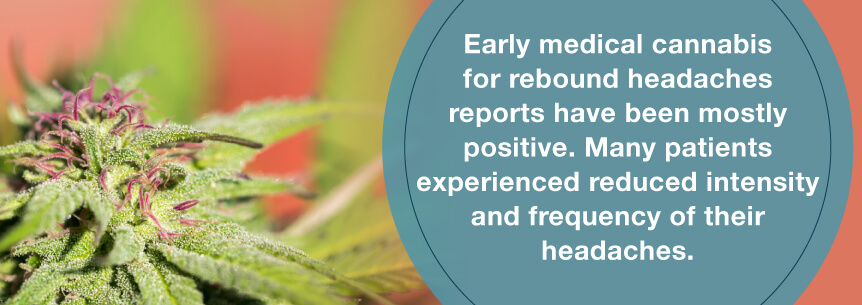
Additionally, early medical cannabis for rebound headaches reports have been mostly positive. Many patients experienced reduced intensity and frequency of their headaches, according to researchers in a study. In some cases, headaches were cured entirely even after the patients stopped using cannabis. These reports also claim long-term marijuana use is safe and has other benefits like reducing anxiety and nausea associated with headaches.
Researchers have been studying medical marijuana and its cannabinoids for other conditions, and marijuana shows effectiveness in treating:
Researchers also associate these conditions with the experience of headaches qualitatively and mechanistically. They find it reasonable to believe the effectiveness of medical weed and cannabinoids can carry over to headache disorder treatment as well.
For instance, the painkilling properties of cannabis that can be seen in neuropathic pain treatment will likely help with chronic headaches. The antiemetic properties seen in chemotherapy-related nausea treatment may also help with nausea caused by migraines, and the antispasmodic properties seen in multiple sclerosis treatments may work well in muscle strain-inducing tension headaches.
Medical weed’s cannabinoids go into your body when you use it and look for the receptors. These cannabinoids change the workings of these receptors, calming down pain signals.
Cannabinoids can also be helpful with the following:
The cannabinoid, THC, is the main reason cannabis is popular. It’s the compound that gives you the “high” or relaxed state you get after using the herb. However, cannabidiol (CBD) is the other compound in cannabis helping to ease pain without the “high” feeling. CBD is now legal in several states to use for medicinal purposes such as fighting fatigue, nausea, pain and trouble sleeping.
When you have a headache strike, it can feel like your entire world is shattering. Headache pain can be completely debilitating. Marijuana for rebound headaches can thankfully help with this. Below are some popular strains for headache pain:
Not all marijuana and rebound headaches strains affect your brain positively, however. So you’ll want to consult with a marijuana doctor or experienced budtender to help you choose the right strain for your rebound headaches. Some strains can give you an opposite effect and cause a headache themselves.
The methods providing you with the quickest effects are inhalation methods. They act quickly and are more likely to stop your rebound headaches in its tracks. Edible marijuana takes a little longer to give you headache relief and can come with intense euphoria, so you’ll want to start with lower doses first and work your way up.
You may also want to try rubbing some marijuana topical on the back of your neck and temples for extra pain relief. This method also gives you fast relief from inflammation to the localized area.
When you’re looking to start your cannabis and rebound headaches treatment, you’ll need to start by finding the right doctor. You can spend all day calling doctor after doctor to see if they specialize in medical marijuana, or you can browse for a medical marijuana dispensary or find a cannabis doctor all in one quick place through MarijuanaDoctors.com.
Find A Doctor Find A Dispensary